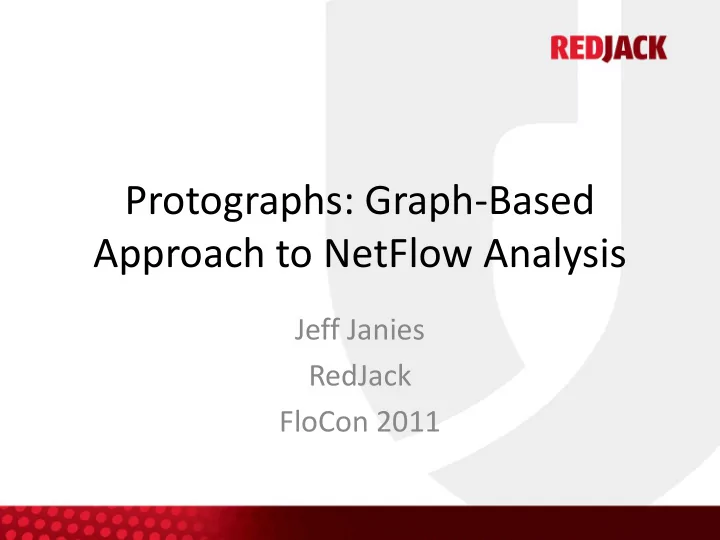

Protographs: Graph-Based Approach to NetFlow Analysis Jeff Janies RedJack FloCon 2011
Thesis • Using social networks we can complement our existing volumetric analysis. – Identify phenomenon we are missing because they are just not “bandwidth heavy” enough. – Relate behaviors in novel ways. – What is really the most important host in a collection a network?
Social Network Analysis • Demonstrates relationships through Graphs – Allows us to map out interconnections. • Objective measure of social importance – Who connects the groups together? – Who can influence communication? 3
Protocol Graphs • Protocol Graphs – Social networks of host communications. (Who talked to whom) – Undirected Graphs – Vertices – The hosts that communicated. – Edges – Connects between hosts that communicated. • Analyze a specific phenomenon. – Ex: BotNet, P2P, Established services
Protograph Tool • Processes raw SiLK NetFlow data. • Produces protocol graphs. – Only uses IP information. • Reports centrality of hosts. – Centrality – How integral a host is to the group. 5
Example NetFlow SI P DI P Sport Dport Flags Bytes Pkts Stim e 192.168.1.100 192.168.1.1 21234 80 SAF 220 4 2010/ 01/ 01T.. 192.168.1.1 192.168.1.100 80 21234 SAF 60035 5 2010/ 01/ 01T.. 10.0.1.35 192.168.1.15 32143 8080 SAR 180 4 2010/ 01/ 01T.. 192.168.1.15 10.0.1.35 8080 32143 SAR 502 5 2010/ 01/ 01T.. 10.0.1.35 192.168.1.100 32144 8080 SAR 180 4 2010/ 01/ 01T.. 192.168.1.100 10.0.1.35 8080 32144 SAR 502 5 2010/ 01/ 01T.. 10.0.1.35 192.168.1.115 32145 8080 SAR 180 4 2010/ 01/ 01T.. 192.168.1.115 10.0.1.35 8080 32145 SAR 502 5 2010/ 01/ 01T.. 10.0.1.35 192.168.1.200 32146 8080 SAR 180 4 2010/ 01/ 01T.. 192.168.1.200 10.0.1.35 8080 32146 SAR 502 5 2010/ 01/ 01T.. 6
NetFlow as a Protocol Graph • That NetFlow Makes this graph. – No Volume. – No Direction. – Just Connections. • Centrality – 10.0.1.35 • Connects many. – 192.168.1.100 • Connects 192.168.1.1 to the rest of the graph. – If either removed, the graph is no longer fully connected. 7
Centrality • A measure of social importance. • Betweenness – How efficiently a vertex connects the graph. (protograph) • Degree – How many vertices are connected to the vertex. (SiLK’ rwuniq) • Closeness – How close a vertex is to other vertices. • Eigenvector – How “important” a vertex is.
Betweenness • Which hosts provide the most shortest paths through the network? • g ij – Geodesic paths through host i and j . • G ikj – Geodesic paths through host k for i and j.
Interpretation • The higher the centrality value the more "important” a host is to the graph. – Without a central node the graph will break down into unconnected groups. (The protocol is effected) – Example: • If we have all a sample of P2P traffic, centrality tells us which host to remove to cause the most damage to the overlay’s QoS. – Not necessarily which host is the most talkative. 10
Volume & Betweenness • Spikes in centrality may exist without spikes in bandwidth. – Centrality measures something not tied to volume. • Sample data: – One week long sample of TCP/IP traffic. – Ephemeral port to ephemeral port. – >1K bytes, >4 packets. – Divided into intervals of 60, 30, and 15 minutes.
Volume measures
Betweenness Centrality
Betweenness Centrality Spike 1 Spike 2
Volume measures Spike 1 Spike 2
Spike 1 • 3 hosts have 4x the centrality measure of any host measured at any other time. – all three part of same phenomenon. – One host was a scan victim of two unrelated hosts. • The only overlap in scan victims was this host. • One scanned ~37,000 destinations on port 20,000. (usermin exploit) • One SA scanned ~3,500 destinations. (various ports)
Spike 2 • 1 host has 3x the centrality of any other host measured at any other time. – Contacts 20,000 hosts that connect a graph of 31,000 hosts. • Active for 6 minutes and sent out 17 million packets. • Scanner.
Second Data Sample • Increased resolution to one minute intervals. • One Week of TCP/IP ephemeral port to ephemeral port traffic: – >120 bytes per direction. – >3 packets. – Contains at least a SYN and ACK flag in the OR of observed Flags.
Betweenness and Degree • Comparing centralities gives richer understanding of hosts’ relationships. • Examine hosts that have high Betweenness with modest Degree. – Hosts that are important without being directly connected to many other hosts.
Volume Vs. Centralities
Only Betweenness Spikes • Recorded each IP address’ max Degree and Betweenness values. • Divided spikes, or exceedingly high Betweenness centralities into strata. – High (>10,000) - All IP addresses also had comparatively high Degree centrality. – Low (>1,000 and <10,000) - We investigated 11 IP addresses that had spikes in Betweenness without comparatively high Degree.
High Betweenness Low Degree • 9 victims of vulnerability scans. – Vulnerability scans requiring full connections. – Scanner connects them to a lot of hosts. • 1 contacted a host that contacted everything. – It provides a service for a promiscuous host. • 1 connected several of the hosts with high Degree and Betweenness centrality. – Connecting segments of a P2P network. • Easily identified high value asset to the P2P network.
Summary • Social network analysis: – Identifying components of a behavior. – Complementary tool to volumetric measures. • It does not consider direction or volume. • Still a great deal of tuning required to make this into an actionable utility. 23
References • Stephen P. Borgatti, “Centrality and Network flow”, Social Neworks, Vol. 27, No. 1. 2005.
Recommend
More recommend